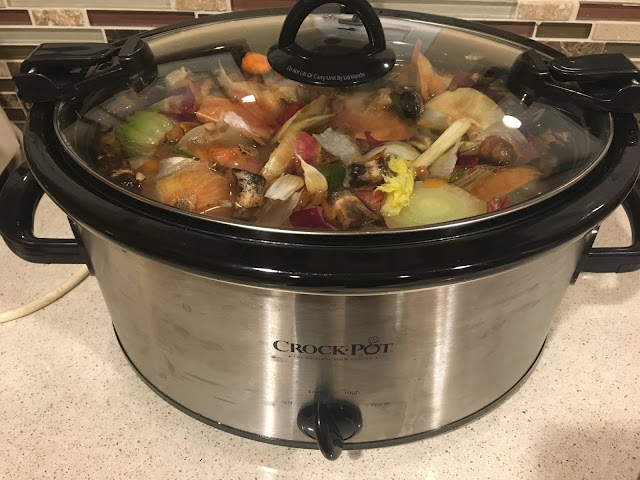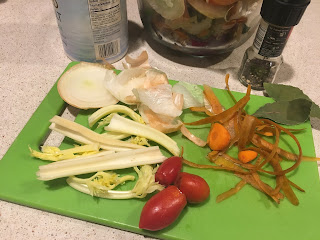
Recipe: No-waste method lets you customize a kitchen staple
 |
| Great broth in the making: Veggie scraps, water and heat. (Photos: Kathy Morrison) |
It’s finally the time of year when I don’t mind heating up the kitchen to make soup, stew or risotto.
I like chicken broth just fine, but prefer to use vegetable stock or broth for these type of dishes. The handy aseptic packages in the grocery store hide a lot of information, however. Is this kind tomato-y or more oniony? How earthy is that broth that has mushrooms listed in the ingredients?
The easy answer to this (no surprise) is to make your own. The recipe below is more method than prescription, as you’ll see.
Since we’re all gardeners or aspiring gardeners here, I’m going to assume you’re already composting your kitchen scraps. Many of those scraps can be used to flavor vegetable broth for several dishes -- and they still can be composted afterwards.
The trick is to use your freezer, and to assess every vegetable bit before it hits the compost bin. Onion tops? Yes. Dried-out garlic cloves? Yes again. Carrot peelings? Absolutely. Other favorites in my house include mushroom stems, celery leaves and ends, limp tomatoes and wilted spinach. I keep them in a gallon freezer bag and add to it over the course of several weeks. Sometimes I have two bags going, for different ingredients.

|
Comments
0 comments have been posted.Sacramento Digs Gardening to your inbox.
Food in My Back Yard Series
April 29: What's (already) wrong with my tomato plants?
April 22: Should you stock up on fertilizer? (Yes!)
April 15: Grow culinary herbs in containers
April 8: When to plant summer vegetables
April 1: Don't be fooled by these garden myths
March 25: Fertilizer tips: How to 'feed' your vegetables for healthy growth
March 18: Time to give vegetable seedlings some more space
March 11: Ways to win the fight against weeds
March 4: Potatoes from the garden
Feb. 25: Plant a fruit tree now -- for later
Feb. 18: How to squeeze more food into less space
Feb. 11: When to plant? Consider staggering your transplants
Feb. 4: Starting in seed starting
Sites We Like
Garden Checklist for week of May 4
Enjoy this spring weather – and get gardening!
* Plant, plant, plant! It’s prime planting season in the Sacramento area. Time to set out those tomato transplants along with peppers and eggplants. Pinch off any flowers on new transplants to make them concentrate on establishing roots instead of setting premature fruit.
* Direct-seed melons, cucumbers, summer squash, corn, radishes, pumpkins and annual herbs such as basil.
* Harvest cabbage, lettuce, peas and green onions.
* In the flower garden, direct-seed sunflowers, cosmos, salvia, zinnias, marigolds, celosia and asters. (You also can transplant seedlings for many of the same flowers.)
* Plant dahlia tubers. Other perennials to set out include verbena, coreopsis, coneflower and astilbe.
* Transplant petunias, marigolds and perennial flowers such as astilbe, columbine, coneflowers, coreopsis, dahlias, rudbeckia and verbena.
* Keep an eye out for slugs, snails, earwigs and aphids that want to dine on tender new growth.
* Feed summer bloomers with a balanced fertilizer.
* For continued bloom, cut off spent flowers on roses as well as other flowering plants.
* Add mulch to the garden to maintain moisture. Mulch also cuts down on weeds. But don’t let it mound around the stems or trunks of trees or shrubs. Leave about a 6-inch to 1-foot circle to avoid crown rot or other problems.